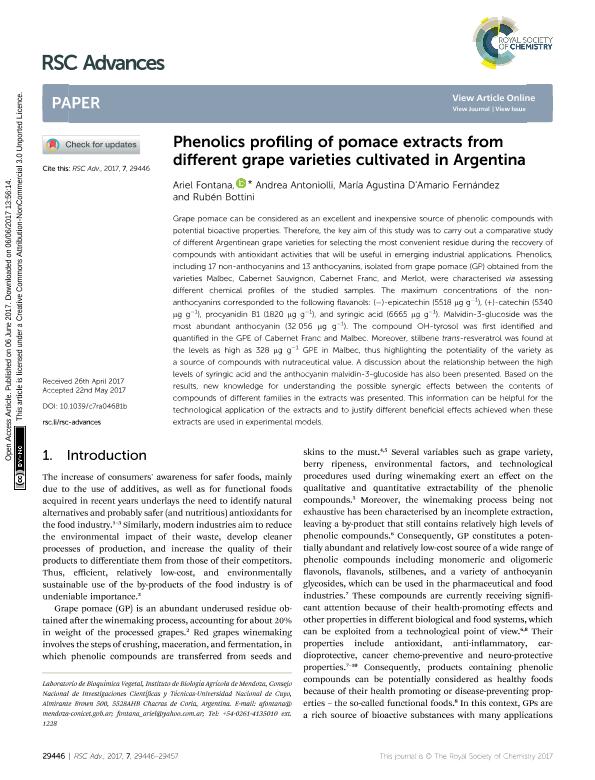Mostrar el registro sencillo del ítem
dc.contributor.author
Fontana, Ariel Ramón

dc.contributor.author
Antoniolli, Andrea Noelia

dc.contributor.author
D'Amario Fernández, María Agustina
dc.contributor.author
Bottini, Ambrosio Rubén

dc.date.available
2018-11-09T20:31:47Z
dc.date.issued
2017-06
dc.identifier.citation
Fontana, Ariel Ramón; Antoniolli, Andrea Noelia; D'Amario Fernández, María Agustina; Bottini, Ambrosio Rubén; Phenolics profiling of pomace extracts from different grape varieties cultivated in Argentina; Royal Society of Chemistry; RSC Advances; 7; 47; 6-2017; 29446-29457
dc.identifier.issn
2046-2069
dc.identifier.uri
http://hdl.handle.net/11336/64150
dc.description.abstract
Grape pomace can be considered as an excellent and inexpensive source of phenolic compounds with potential bioactive properties. Therefore, the key aim of this study was to carry out a comparative study of different Argentinean grape varieties for selecting the most convenient residue during the recovery of compounds with antioxidant activities that will be useful in emerging industrial applications. Phenolics, including 17 non-anthocyanins and 13 anthocyanins, isolated from grape pomace (GP) obtained from the varieties Malbec, Cabernet Sauvignon, Cabernet Franc, and Merlot, were characterised via assessing different chemical profiles of the studied samples. The maximum concentrations of the non-anthocyanins corresponded to the following flavanols: (-)-epicatechin (5518 μg g-1), (+)-catechin (5340 μg g-1), procyanidin B1 (1820 μg g-1), and syringic acid (6665 μg g-1). Malvidin-3-glucoside was the most abundant anthocyanin (32 056 μg g-1). The compound OH-tyrosol was first identified and quantified in the GPE of Cabernet Franc and Malbec. Moreover, stilbene trans-resveratrol was found at the levels as high as 328 μg g-1 GPE in Malbec, thus highlighting the potentiality of the variety as a source of compounds with nutraceutical value. A discussion about the relationship between the high levels of syringic acid and the anthocyanin malvidin-3-glucoside has also been presented. Based on the results, new knowledge for understanding the possible synergic effects between the contents of compounds of different families in the extracts was presented. This information can be helpful for the technological application of the extracts and to justify different beneficial effects achieved when these extracts are used in experimental models.
dc.format
application/pdf
dc.language.iso
eng
dc.publisher
Royal Society of Chemistry

dc.rights
info:eu-repo/semantics/openAccess
dc.rights.uri
https://creativecommons.org/licenses/by-nc-sa/2.5/ar/
dc.subject
Phenolics
dc.subject
Grapes
dc.subject.classification
Otras Ciencias Químicas

dc.subject.classification
Ciencias Químicas

dc.subject.classification
CIENCIAS NATURALES Y EXACTAS

dc.title
Phenolics profiling of pomace extracts from different grape varieties cultivated in Argentina
dc.type
info:eu-repo/semantics/article
dc.type
info:ar-repo/semantics/artículo
dc.type
info:eu-repo/semantics/publishedVersion
dc.date.updated
2018-10-23T15:54:18Z
dc.journal.volume
7
dc.journal.number
47
dc.journal.pagination
29446-29457
dc.journal.pais
Reino Unido

dc.description.fil
Fil: Fontana, Ariel Ramón. Consejo Nacional de Investigaciones Científicas y Técnicas. Centro Científico Tecnológico Conicet - Mendoza. Instituto de Biología Agrícola de Mendoza. Universidad Nacional de Cuyo. Facultad de Ciencias Agrarias. Instituto de Biología Agrícola de Mendoza; Argentina
dc.description.fil
Fil: Antoniolli, Andrea Noelia. Consejo Nacional de Investigaciones Científicas y Técnicas. Centro Científico Tecnológico Conicet - Mendoza. Instituto de Biología Agrícola de Mendoza. Universidad Nacional de Cuyo. Facultad de Ciencias Agrarias. Instituto de Biología Agrícola de Mendoza; Argentina
dc.description.fil
Fil: D'Amario Fernández, María Agustina. Universidad Nacional de Cuyo, Facultad de Ciencias Agrarias; Argentina
dc.description.fil
Fil: Bottini, Ambrosio Rubén. Consejo Nacional de Investigaciones Científicas y Técnicas. Centro Científico Tecnológico Conicet - Mendoza. Instituto de Biología Agrícola de Mendoza. Universidad Nacional de Cuyo. Facultad de Ciencias Agrarias. Instituto de Biología Agrícola de Mendoza; Argentina
dc.journal.title
RSC Advances
dc.relation.alternativeid
info:eu-repo/semantics/altIdentifier/doi/http://dx.doi.org/10.1039/c7ra04681b
dc.relation.alternativeid
info:eu-repo/semantics/altIdentifier/url/https://pubs.rsc.org/en/Content/ArticleLanding/2017/RA/C7RA04681B
Archivos asociados
